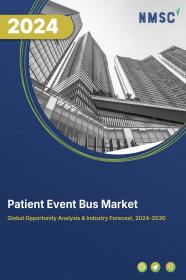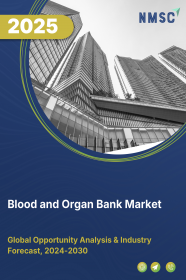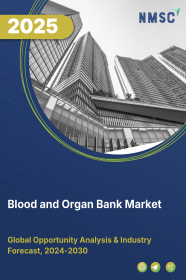
Patient Event Bus Market by Component (Software & Services), by Deployment Model (On-premises & Cloud-based), by End-User (Hospitals and Clinics, Ambulatory Care Centers, Research Institutes), by Application (Electronic Health Record (EHR) Integration, Real-time Patient Monitoring, Clinical Decision Support Systems, Population Health Management, Telehealth, and Remote Patient Monitoring) – Global Opportunity Analysis and Industry Forecast 2024–2030
US Tariff Impact on Patient Event Bus Market
Trump Tariffs Are Reshaping Global Business
Market Definition
The global Patient Event Bus Market was valued at USD 151.3 million in 2023 and is predicted to reach USD 415.7 million by 2030, with a CAGR of 15.5% from 2024 to 2030. The Patient Event Bus is a centralized communication system within healthcare infrastructure designed to facilitate real-time data exchange and event notifications across various healthcare systems, such as electronic health records (EHRs), patient monitoring devices, and clinical applications.
This event-driven architecture enables seamless interoperability between disparate healthcare systems by transmitting patient-related events, such as admissions, discharges, medication updates, or lab results, in a standardized format.
The patient event bus enhances care coordination, improves clinical workflows, and supports timely decision-making by ensuring that relevant healthcare stakeholders are notified promptly about critical patient events, thereby enhancing overall patient care and safety.
Market Dynamics and Trends
The global patient event bus market is experiencing significant growth, primarily driven by the increasing adoption of digital health technologies across healthcare organizations. As healthcare systems transition towards electronic health records (EHRs) and integrate various clinical applications and medical devices, the need for efficient data exchange and interoperability becomes paramount.
The patient event bus serves as a vital infrastructure component, facilitating seamless communication between these diverse systems, thereby streamlining workflows and enhancing care coordination.
Moreover, the growing emphasis on patient-centric care healthcare models further fuels the demand for patient event bus solutions. Healthcare providers are under pressure to improve patient outcomes while optimizing costs.
By enabling real-time notification and data sharing of patient events such as admissions, transfers, and discharge summaries, the patient event bus helps healthcare organizations in proactively managing patient care, reducing readmission rates, and ensuring smoother transitions across care settings.
Additionally, regulatory initiatives and standards play a significant role in driving the adoption of patient transport business solutions. Governments and regulatory bodies worldwide are mandating interoperability standards and requirements to promote data exchange and enhance healthcare interoperability.
Compliance with regulations such as the Health Insurance Portability and Accountability Act (HIPAA) in the United States or the European Union's General Data Protection Regulation (GDPR) necessitates robust data-sharing mechanisms, making patient event bus solutions indispensable for healthcare providers to remain compliant.
Furthermore, the rise of telehealth and remote patient monitoring further drives the need for patient event bus solutions. As healthcare delivery extends beyond traditional clinical settings, ensuring seamless communication between remote monitoring devices, telehealth platforms, and EHR systems becomes critical for delivering timely and effective care.
The patient event bus enables bi-directional data exchange between these disparate systems, supporting remote patient management and virtual care delivery models. However, the complexity of integrating different healthcare systems and technologies is restricting the growth of the patient event bus market.
Many healthcare organizations operate on legacy systems that lack interoperability, making it challenging to seamlessly connect them with a patient event bus. On the contrary, the growing emphasis on value-based care and population health management presents significant opportunities for patient event bus vendors.
Healthcare providers are increasingly focused on improving patient outcomes, reducing costs, and enhancing care coordination across the continuum. This is expected to create ample opportunities for the market in the future.
Market Segmentations and Scope of the Study
The patient event bus market share is segmented on the basis of component, deployment model, end user, application and geography. On the basis of component, the market is divided into software and services.
On the basis of deployment model, the market is segmented into on-premises & cloud-based. On the basis of end-user, the market is separated into hospitals and clinics, ambulatory care centers, research institutes.
Based on application, the market is classified into electronic health record (EHR) integration, real-time patient monitoring, clinical decision support systems, population health management, telehealth, and remote patient monitoring. Geographic breakdown and analysis of each of the aforesaid segments include regions comprising North America, Europe, Asia-Pacific, and Row.
Geographical Analysis
North America is the dominant market for patient event bus solutions at present and is expected to maintain its dominance during the forecast period. The region's advanced healthcare infrastructure and widespread adoption of electronic health records (EHRs) create a conducive environment for market expansion.
With a robust foundation of digital health technologies in place, there's a growing demand for interoperable solutions like patient event bus systems to facilitate seamless communication and data exchange between disparate healthcare systems and applications.
Moreover, regulatory initiatives such as the 21st Century Cures Act in the United States underscore the importance of healthcare interoperability and data exchange, further driving the adoption of patient event bus solutions. Compliance with regulatory requirements mandates the implementation of interoperable systems to facilitate the secure exchange of patient information, enhancing care coordination and patient safety.
This regulatory push accelerates the adoption of patient event bus solutions among healthcare providers in North America. On the other hand, Asia Pacific region is witnessing steady growth in the patient event bus market owing to the rapid digitization of healthcare systems in several countries, fueled by government initiatives and increased investment in healthcare IT infrastructure.
As healthcare organizations transition from paper-based records to electronic health records (EHRs) and digital health solutions, there is a growing need for interoperable systems like Patient Event Bus to facilitate seamless data exchange and communication between disparate healthcare systems and applications.
Moreover, several countries in Asia Pacific, including India, China, and Southeast Asian nations, are emerging as key markets for healthcare IT solutions. Rapid urbanization, increasing disposable income, and improving healthcare infrastructure are driving the demand for advanced healthcare technologies, including interoperable solutions including patient event bus. As healthcare organizations in these markets invest in modernizing their IT infrastructure, the demand for patient event bus solutions is expected to grow significantly.
Competitive Landscape
The patient event bus industry includes several market players such as InterSystems Corporation, Cerner Corporation, Epic Systems Corporation, Allscripts Healthcare Solutions, Microsoft Corporation, Google Cloud Healthcare, Amazon Web Services (AWS) Healthcare, IBM Healthcare, Meditech, and Health Level Seven International (HL7). These market players continue to adopt various market development strategies including new launches across various regions to maintain their dominance in the global market.
For instance, in March 2022, InterSystems introduced its latest solution, HealthShare Health Connect Cloud, tailored for the Patient Event Bus market. This Platform-as-a-Service (PaaS) offering aims to revolutionize data integration and connectivity across clinical systems and applications. By seamlessly linking various healthcare systems, including electronic health records (EHRs), patient monitoring devices, and clinical applications, HealthShare Health Connect Cloud simplifies the exchange of patient events in real time.
Key Benefits
-
The report provides a quantitative analysis of the current patient event bus market estimations through 2024-2030 that assists in identifying the prevailing market opportunities to capitalize on.
-
The study comprises a deep-dive analysis of the current and future patient event bus market trends to depict the prevalent investment pockets in the market.
-
The information related to key drivers, restraints, and opportunities and their impact on the market is provided in the report.
-
The competitive analysis of the market players along with their market share in the Patient event bus market.
-
The SWOT analysis and Porter’s Five Forces model are elaborated in the study.
-
Value chain analysis in the market study provides a clear picture of the stakeholders’ roles.
Key Market Segments
By Component
-
Software
-
Services
By Deployment Model
-
On-premises
-
Cloud-based
By End-User
-
Hospitals and Clinics
-
Ambulatory Care Centers
-
Research Institutes
By Application
-
Electronic Health Record (EHR) Integration
-
Real-time Patient Monitoring
-
Clinical Decision Support Systems
-
Population Health Management
-
Telehealth
-
Remote Patient Monitoring
By Region
-
North America
-
The U.S.
-
Canada
-
Mexico
-
-
Europe
-
The U.K.
-
Germany
-
France
-
Italy
-
Spain
-
Denmark
-
Netherlands
-
Finland
-
Sweden
-
Norway
-
Russia
-
Rest of Europe
-
-
Asia-Pacific
-
China
-
Japan
-
India
-
South Korea
-
Australia
-
Indonesia
-
Singapore
-
Taiwan
-
Thailand
-
Rest of Asia-Pacific
-
-
Rest of the World (RoW)
-
Latin America
-
Middle East
-
Africa
-
Key Players
-
InterSystems Corporation
-
Cerner Corporation
-
Epic Systems Corporation
-
Allscripts Healthcare Solutions
-
Microsoft Corporation
-
Google Cloud Healthcare
-
Amazon Web Services (AWS) Healthcare
-
IBM Healthcare
-
Meditech
-
Health Level Seven International (HL7)
REPORT SCOPE AND SEGMENTATION:
|
Parameters |
Details |
|
Market Size in 2023 |
USD 151.3 Million |
|
Revenue Forecast in 2030 |
USD 415.7 Million |
|
Growth Rate |
CAGR of 15.5% from 2024 to 2030 |
|
Analysis Period |
2023–2030 |
|
Base Year Considered |
2023 |
|
Forecast Period |
2024–2030 |
|
Market Size Estimation |
Million (USD) |
|
Growth Factors |
|
|
Countries Covered |
28 |
|
Companies Profiled |
10 |
|
Market Share |
Available for 10 companies |
|
Customization Scope |
Free customization (equivalent to up to 80 working hours of analysts) after purchase. Addition or alteration to country, regional, and segment scope. |
|
Pricing and Purchase Options |
Avail customized purchase options to meet your exact research needs. |

















 Speak to Our Analyst
Speak to Our Analyst





















